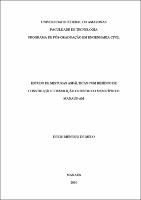| ???jsp.display-item.social.title??? |


|
Please use this identifier to cite or link to this item:
https://tede.ufam.edu.br/handle/tede/4299| ???metadata.dc.type???: | Dissertação |
| Title: | Estudo de misturas asfálticas com resíduo de construção e demolição oriundo do município de Manaus-AM. |
| ???metadata.dc.creator???: | Melo, Diego Meneses de  |
| ???metadata.dc.contributor.advisor1???: | Frota, Consuelo Alves da |
| ???metadata.dc.contributor.referee1???: | Frota, Consuelo Alves da |
| ???metadata.dc.contributor.referee2???: | Cavalcante, Erinaldo Hilário |
| ???metadata.dc.contributor.referee3???: | Rocha, Francisco dos Santos |
| ???metadata.dc.description.resumo???: | A dissertação ora apresentada tem por objetivo realizar estudo sobre a utilização de resíduos de construções e demolições (RCD) como agregado graúdo em concreto asfáltico, buscando solução técnica e ambiental para a carência histórica de agregados pétreos no município de Manaus-AM. A pesquisa expõe características peculiares do material alternativo, comparando com o seixo rolado, elemento usual nas misturas asfálticas utilizadas regionalmente. Realizouse a dosagem de uma mistura com seixo e outra com RCD, cumprindo a função de agregado graúdo, mantendo os demais partícipes constantes: CAP 50/70 como ligante, areia residual como agregado miúdo, cimento Portland como material de enchimento. A definição da granulometria foi feita por meio do Método de Bailey, possibilitando definir um esqueleto estrutural que privilegiasse o intertravamento dos grãos, de modo a estudar a influência da forma e textura superficial no comportamento mecânico da mistura. Como balizadores do desempenho foram realizados ensaios de Resistência à Tração (RT), Perda de Resistência por Umidade Induzida (Ensaio Lottman), Módulo de Resiliência (MR), Fluência por Compressão Axial (creep) estático e dinâmico. Variou-se a temperatura em todos os ensaios, a exceção do Lottman, de modo a investigar a sensibilidade das misturas a este fator. Todos os procedimentos tiveram seus resultados julgados quanto à resistência e deformabilidade. Foi constatada a viabilidade do uso do RCD em concreto asfáltico, em substituição ao seixo, uma vez que o material alternativo mostrou-se, na maior parte dos ensaios, mais estável sob temperaturas maiores que 25°C. Sua resistência à tração foi mais alta que a do seixo, independentemente da temperatura ou da velocidade de carregamento. O Módulo de Resiliência e a deformação acumulada nos ensaios de fluência demonstraram que, para as temperaturas de serviço típicas de Manaus (em torno de 40°C), a mistura alternativa tem melhor desempenho que aquela contendo material natural. Contudo, o RCD se mostrou mais susceptível à ação da umidade. Concluiu-se, baseado nos resultados, que forma irregular e a textura superficial rugosa do agregado de resíduo foi responsável por um aumento no atrito entre as partículas no esqueleto estrutural da mistura, colaborando com a resistência ao cisalhamento, especialmente para as temperaturas mais altas de operação, quando a fase viscosa apresenta grande influência no comportamento mecânico. |
| Abstract: | The dissertation now presented has the objective to accomplish a study about the use of constructions and demolitions waste (CDW) as coarse aggregate in asphalt concrete, searching for environmental and technical solution to the historical stony aggregate lack in the city of Manaus-AM. The research displays peculiar characteristics of the alternative material, comparing with the pebble, usual element in the asphalt mixtures regionally used. It was conducted the dosage of a mixture with pebble and another one with CDW, fulfilling the function of coarse aggregates, keeping the other elements: CAP 50/70 as binder, residual sand as fine aggregate, Portland cement as filler. The gradation definition was made by the Bailey Method, enabling the obtainment of a structural skeleton that privileged the grains interlocking, allowing a study of the form and superficial texture influence in the mixture mechanical behavior. As performance markers was made tests of Tensile Strength (TS), Loss of Resistance by Induced Moisture (Lottman Test), Resilient Modulus (RM), Fluency for Axial Compression (creep), by static and dynamic method. Temperature was varied in all assays, excepted for the Lottman, objecting to investigate the sensitivity of the mixtures to this factor. All the procedures had its results considered as for the resistance and deformability. The viability of the use of the CDW as aggregate in asphalt concrete was evidenced, in substitution to the pebble, because the alternative material revealed, for the most part of the tests, more stability under temperatures higher than 25°C. Its tensile strength was higher than of the pebble, independently of the temperature or the load speed. The Resilient Modulus and the deformation accumulated in the fluency tests demonstrated that, for the typical service temperatures of Manaus (around 40°C), the alternative mixture has better performance than one with natural material. However, CDW showed more susceptibility for the moisture action. It was concluded, based on the results, which the irregular form and the rugous superficial texture of the residue aggregate were responsible for an increase in the friction between particles in the structural skeleton of the mixture collaborating with the shear strength, especially for the highest temperatures of operation, when the viscous phase introduce great influence in the mechanical behavior. |
| Keywords: | Resíduo de Construções e Demolições Misturas Asfálticas Método de Bailey Resistência à Tração Módulo Resiliente Ensaio de Lottman Construction and Demolition Waste Asphalt Mixtures Bailey Method Tensile Strength Resilient Modulus Lottman Test |
| ???metadata.dc.subject.cnpq???: | ENGENHARIAS: ENGENHARIA CIVIL |
| Language: | por |
| ???metadata.dc.publisher.country???: | Brasil |
| Publisher: | Universidade Federal do Amazonas |
| ???metadata.dc.publisher.initials???: | UFAM |
| ???metadata.dc.publisher.department???: | Faculdade de Tecnologia |
| ???metadata.dc.publisher.program???: | Programa de Pós-graduação em Engenharia Civil |
| Citation: | MELO, Diego Meneses. Estudo de misturas asfálticas com resíduo de construção e demolição oriundo do município de Manaus-AM. 2010. 237 f. Dissertação (Mestrado em Engenharia Civil) - Universidade Federal do Amazonas, Manaus, 2010. |
| ???metadata.dc.rights???: | Acesso Aberto |
| URI: | http://tede.ufam.edu.br/handle/tede/4299 |
| Issue Date: | 22-Jul-2010 |
| Appears in Collections: | Mestrado em Engenharia Civil |
Files in This Item:
| File | Description | Size | Format | |
|---|---|---|---|---|
| Dissertação-Diego Meneses de Melo.pdf | 12.67 MB | Adobe PDF |  Download/Open Preview |
Items in DSpace are protected by copyright, with all rights reserved, unless otherwise indicated.




